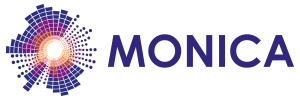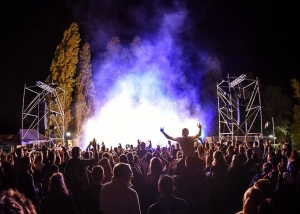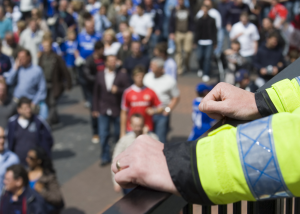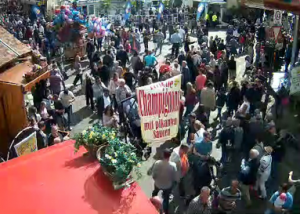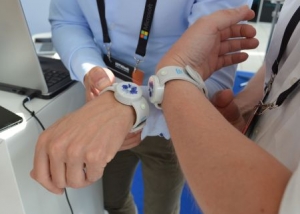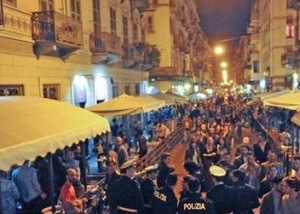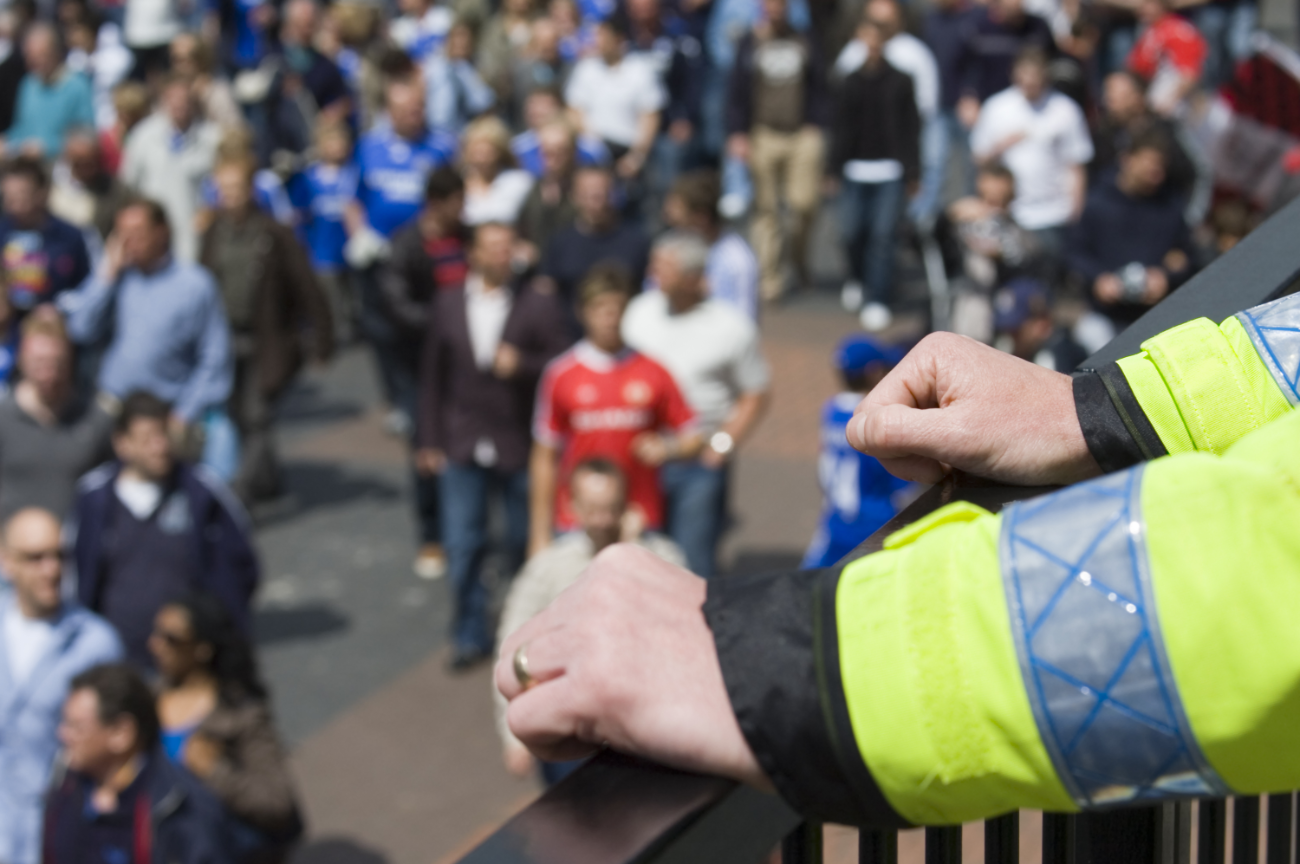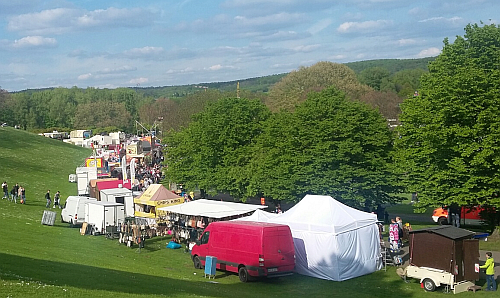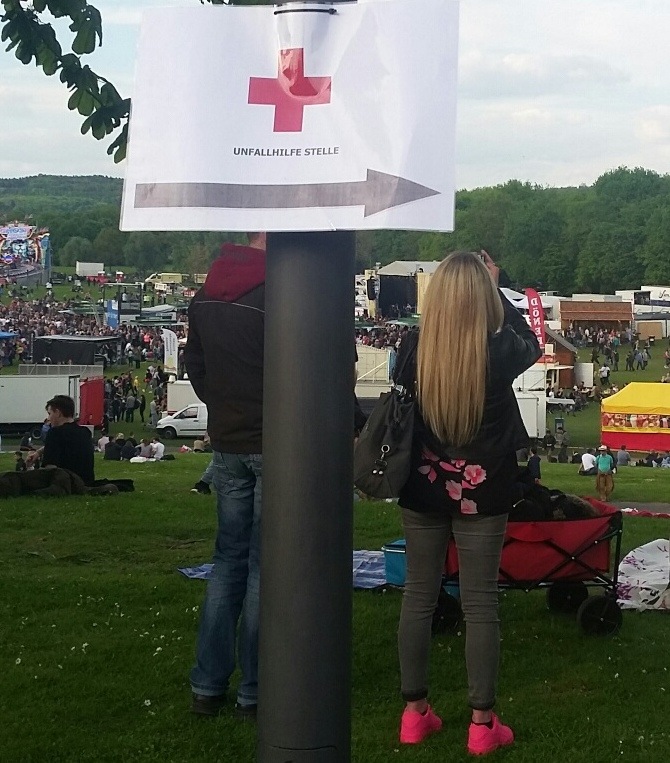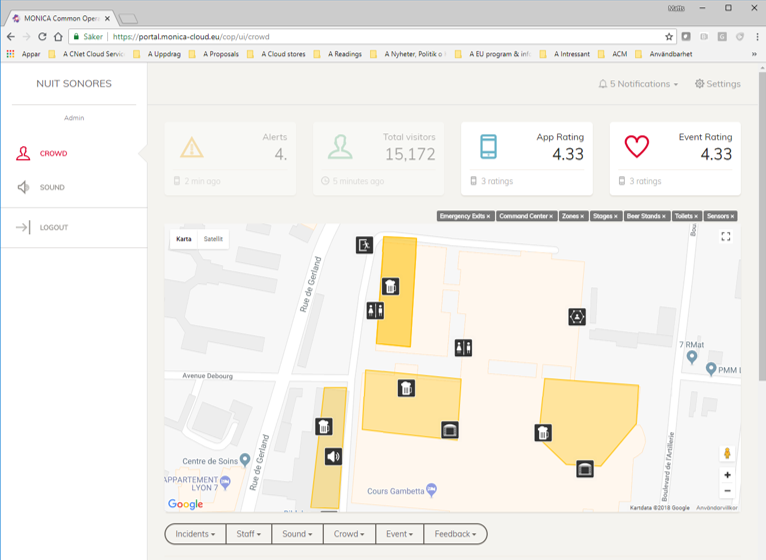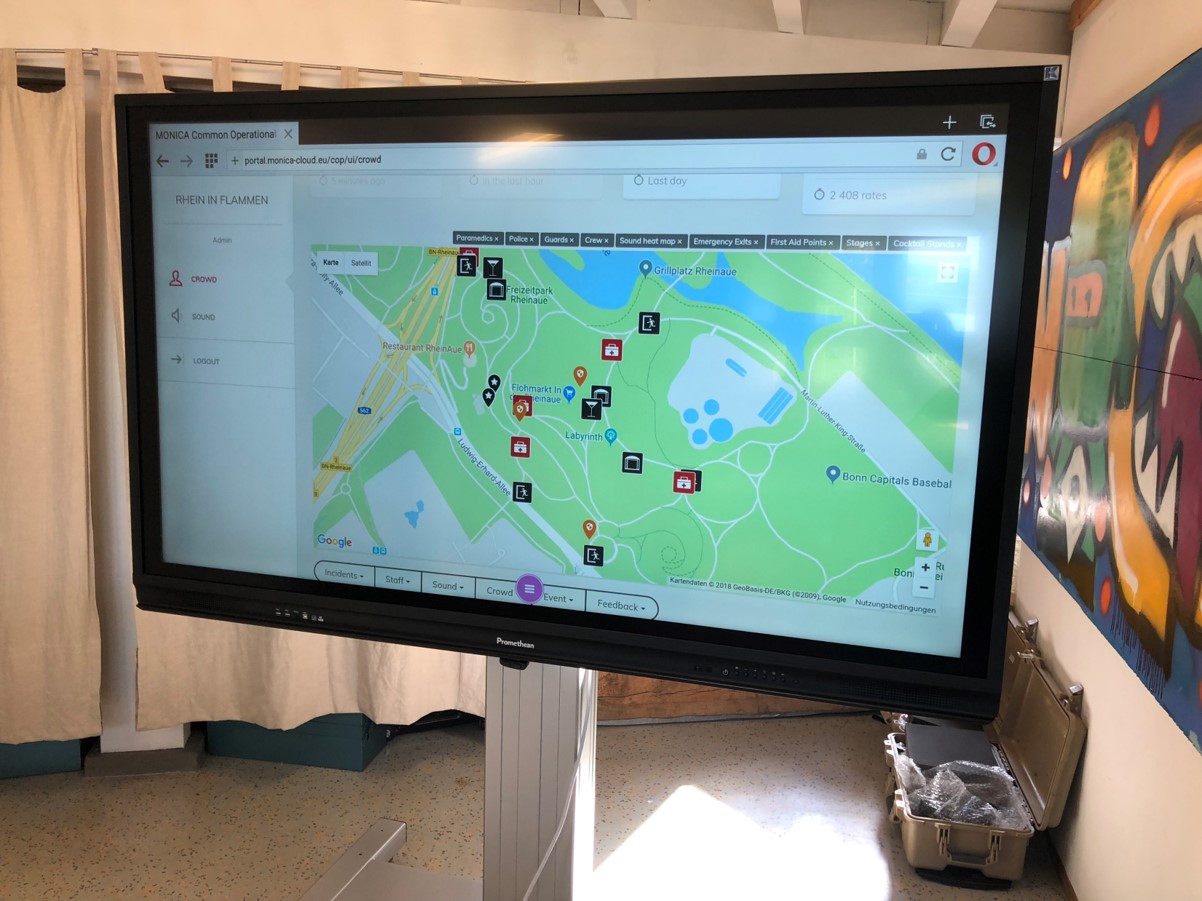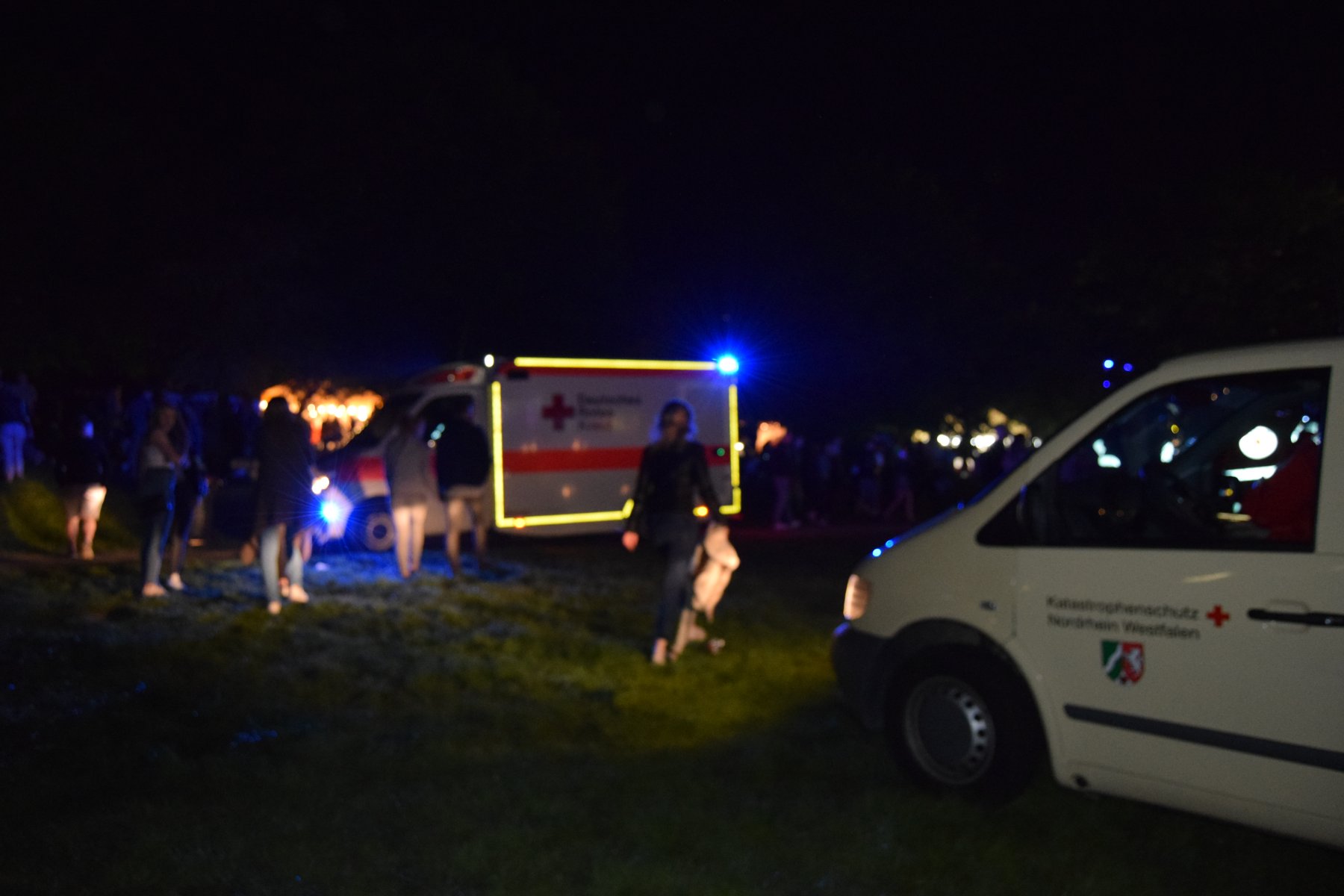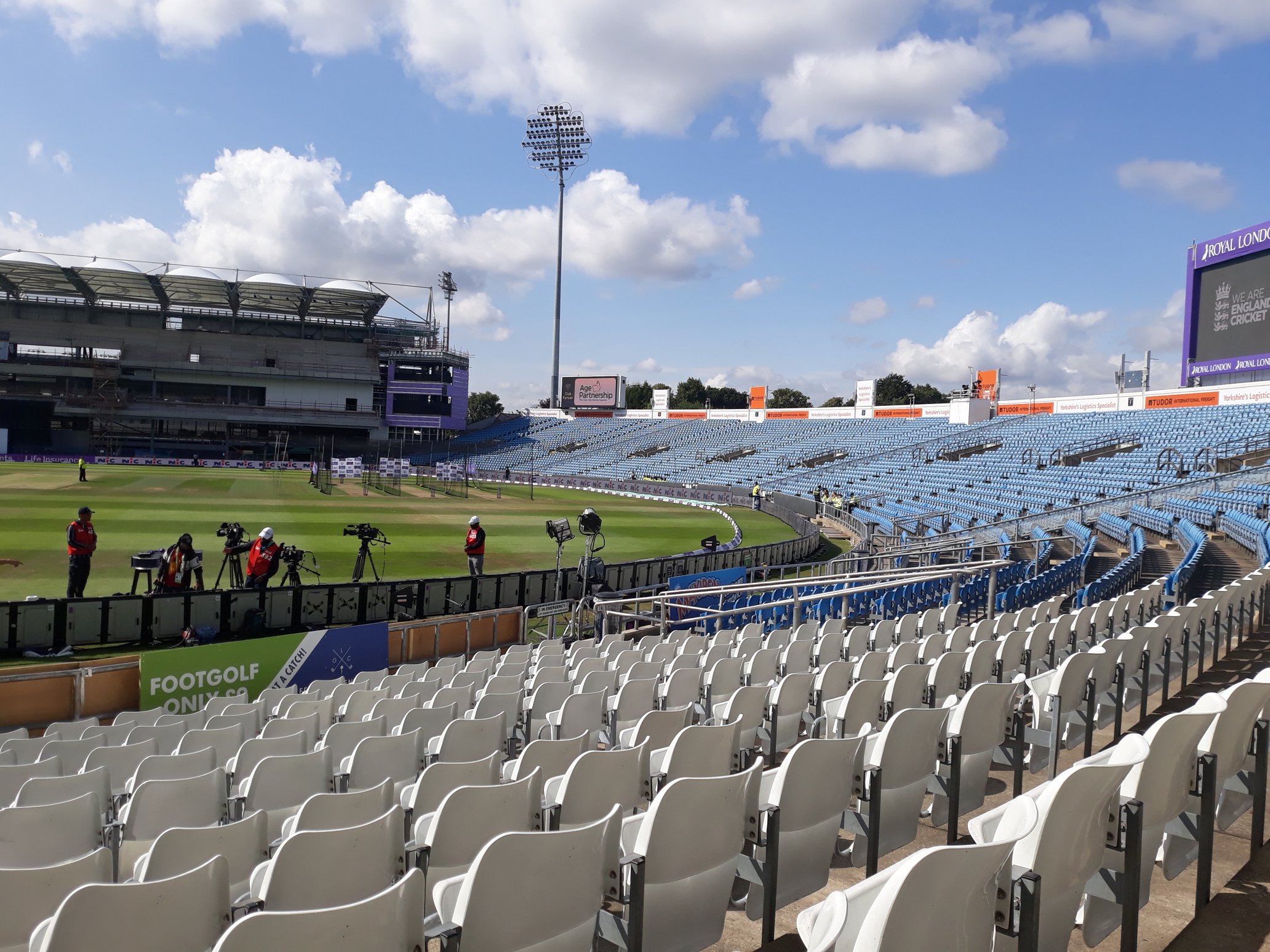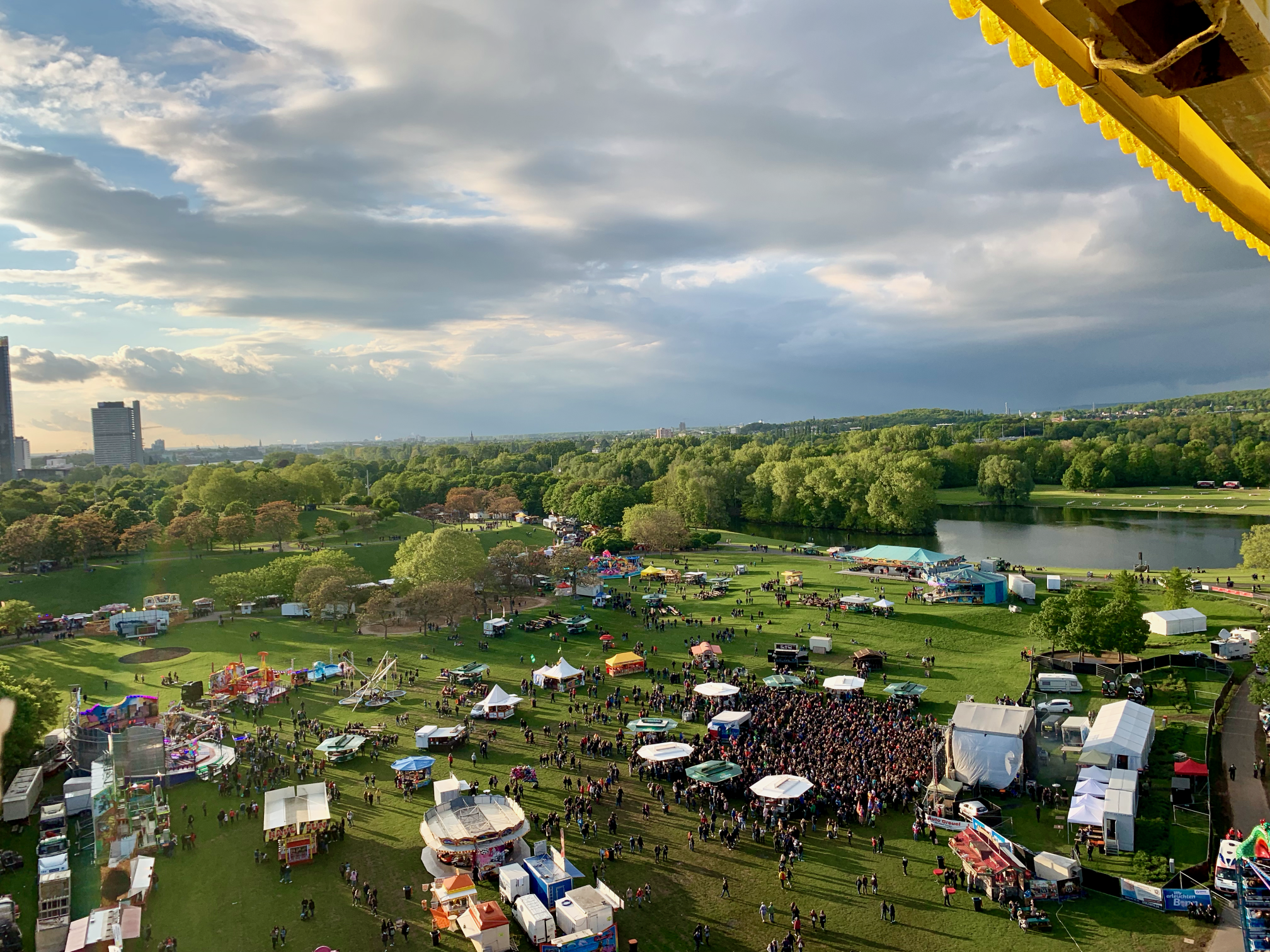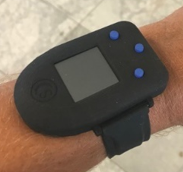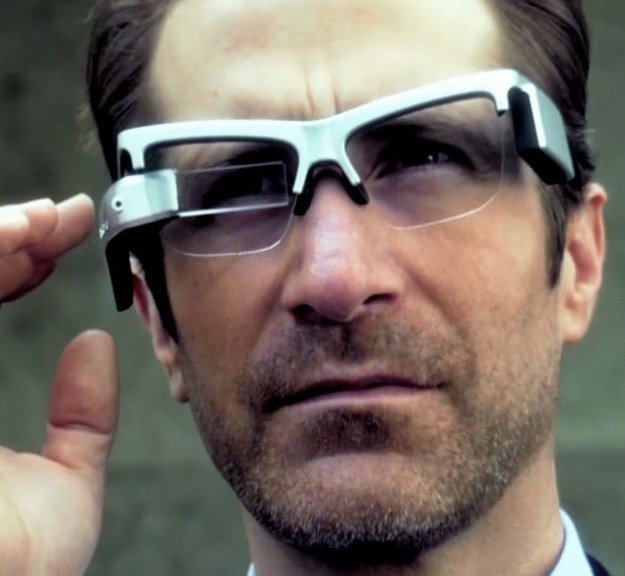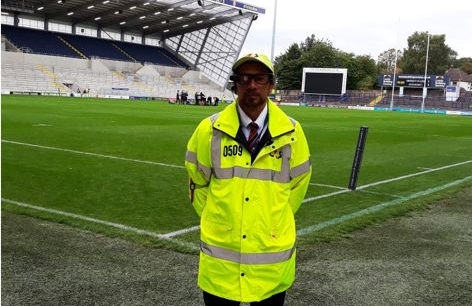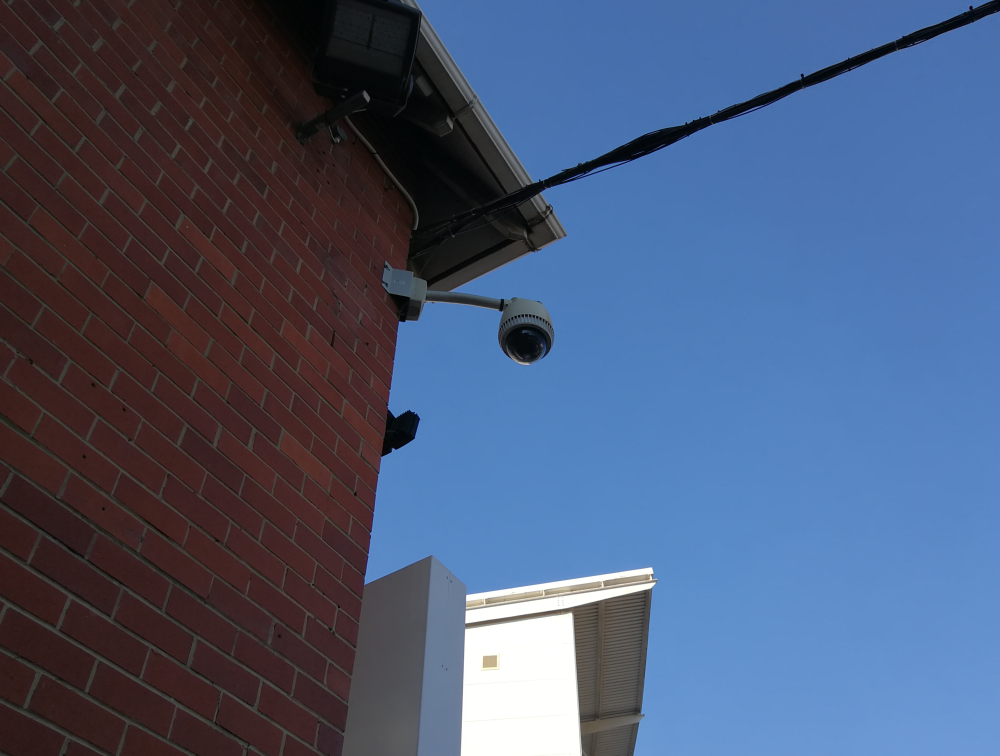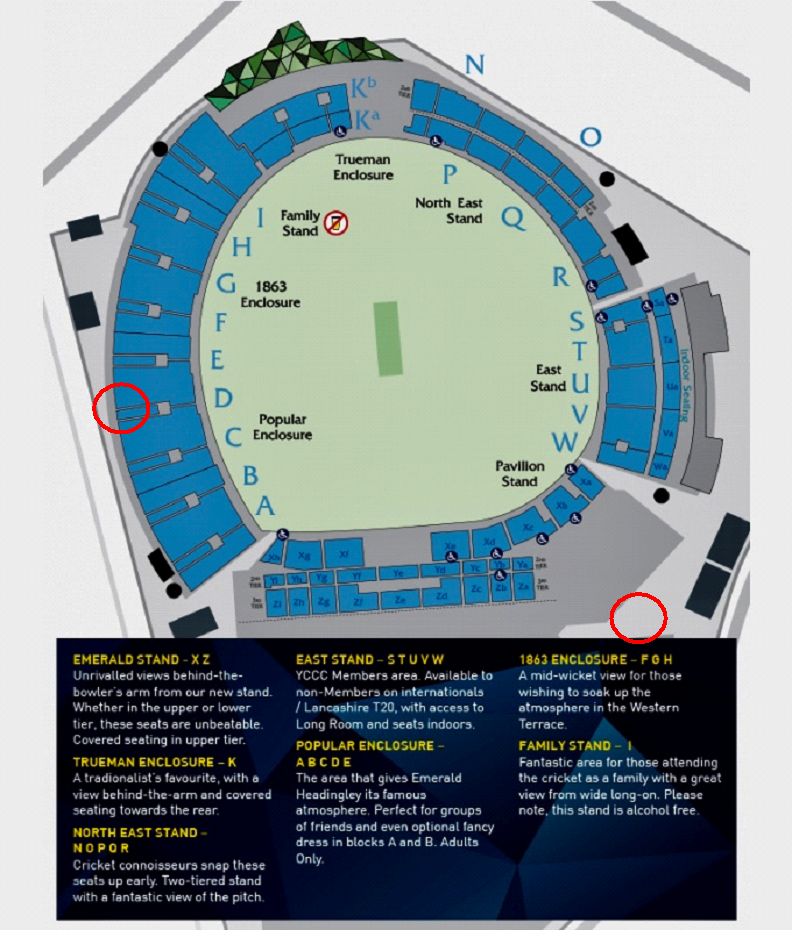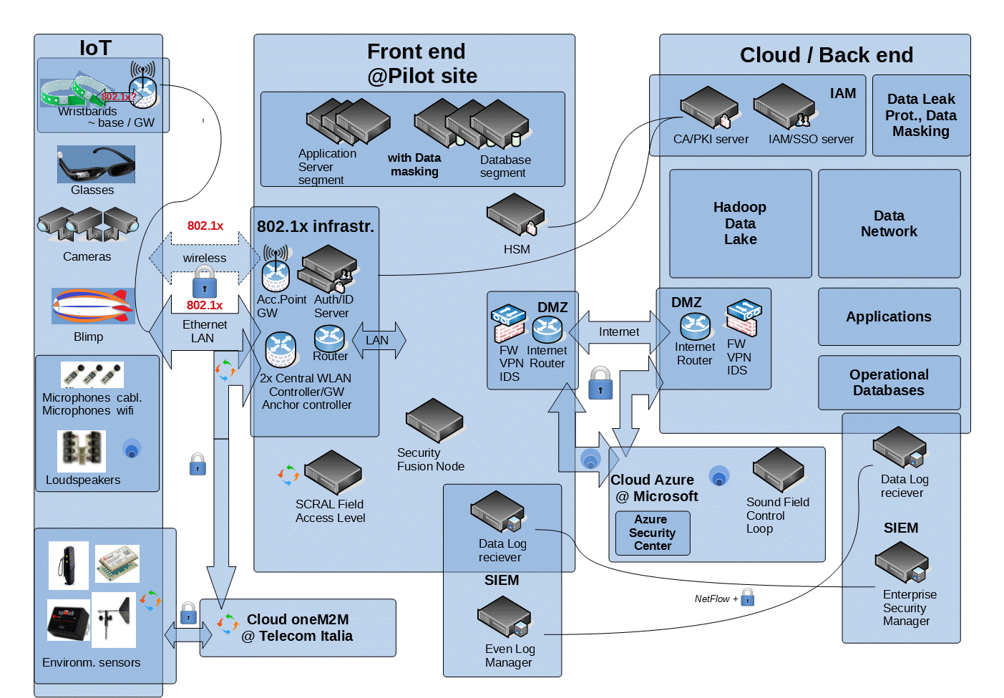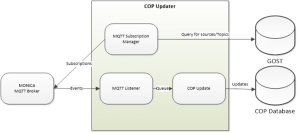Crowd Management and Communication
Crowd management and response is greatly facilitated by the MONICA Crowd Management and Communication solution. This solution gives a perfect overview of event activities in real time as well as means for feed-back to and communication with security and first-responder staff in the field.
This solution complements the MONICA Crowd and Capacity Monitoring solution. The solution also complements the MONICA Sound Level Monitoring solution. Combined they represent a total, closed loop solution for gathering real-time event information and presenting this information for decision support.
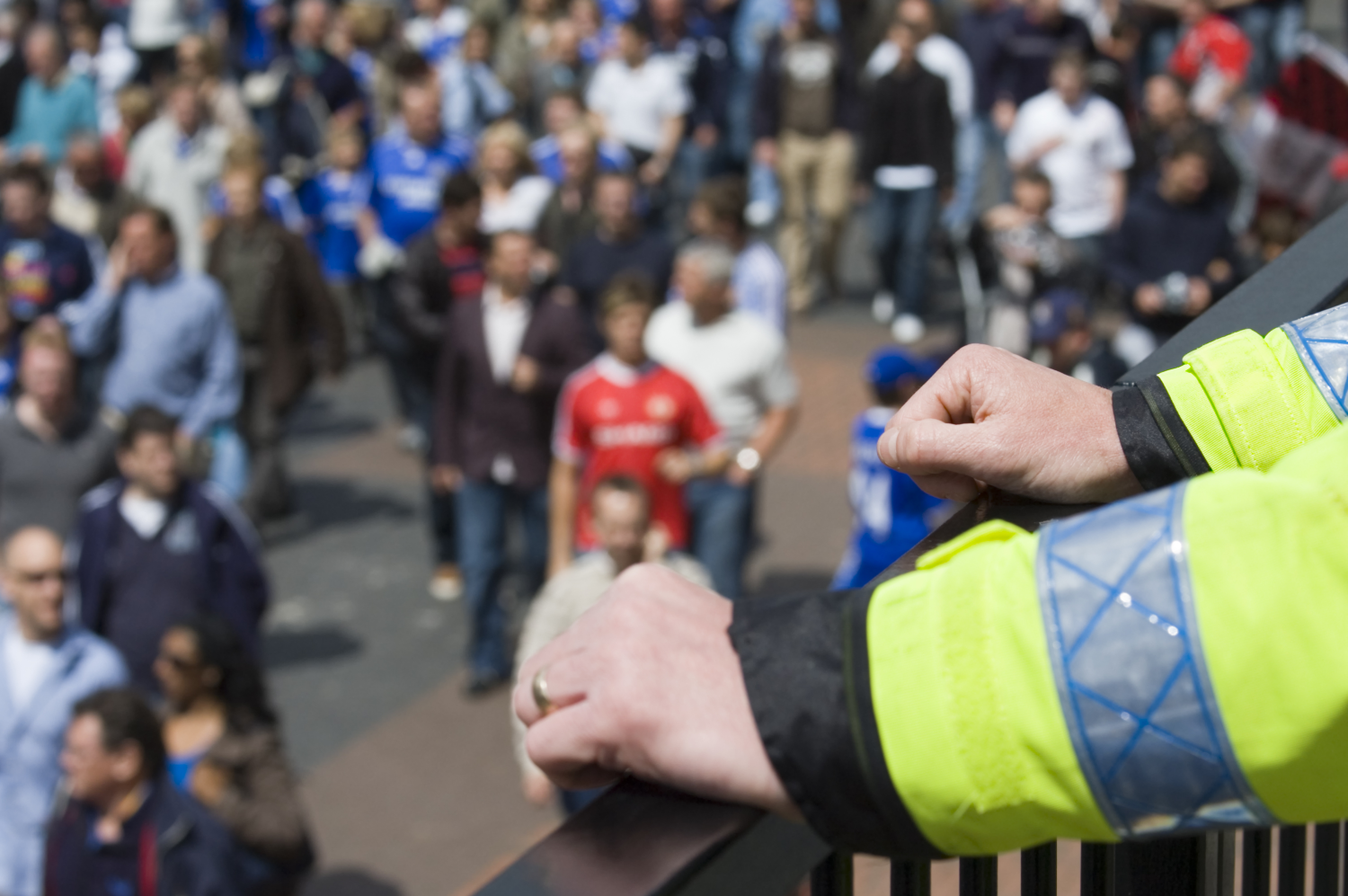
The MONICA Crowd Management and Communication solution is a MONICA Cloud based solution that receives information from the MONICA IoT platform. The IoT platform collects, records, and analyses the environment and behaviour of crowds and event performance. All information is passed on to the MONICA Cloud.
During the event, security and first responder personnel at the control centre can monitor the situation on large display screens using the MONICA Common Operational Picture (COP). The MONICA Decision Support System (DSS) facilitates a better understanding of the event and improved coordination of intervention.
The COP provides real-time overview, quantitative data about crowds and crowd behaviour, and advanced detection of incidents and events. Two-way communication allows on-site personnel to report incidents to the control centre by sending live video stream and images, Staff wristbands and GPS staff trackers communicates with the COP in real time as decision support for control room staff.
Overview
| Applications areas | Type of locations | Main features |
|---|---|---|
|
|
|
Challenges, Features and Benefits
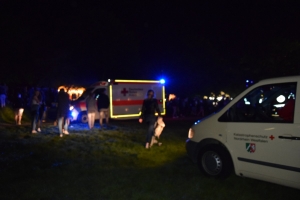
First responders @ Rhein-in-Flammen 2018
All large events need to have adequate safety and security measures in place. In the last two decades the need for enhanced security measures during the numerous city events is sadly increasing, due to the risk of terrorism; open air events are often attended by thousands of people, so crowd management and mitigation of annoyance is becoming a major challenge requiring advanced ICT tools.
On this background, onsite security personnel play a crucial role in ensuring that the event runs smoothly and without major incidents. One of the main challenges for managing security and safety at large events and crowds in venues is to ensure that security staff can communicate efficiently and accurately.
The challenges of crowd management in open-air events are mostly related to:
- getting a full overview of the situation in the field and the behaviour of crowds;
- identifying the precise nature and location of an incident including context such as video;
- providing timely response to incidents;
- tracking the location of on-site security personnel;
- coordinating on-site security personnel in responding to an incident;
- sharing of relevant information between the control room and other on-site personnel.
The MONICA Crowd Management and Communication solution provides a comprehensive tool for overcoming these challenges.
The MONICA Crowd Management and Communication solution is a cloud-based, closed-loop management solution that provides a real-time operational picture with overview, decision support and intervention strategies for event organisers and security and first responder teams during large scale events. It also allows staff to exchange information in a reliable and timely manner to improve the handling of critical incidents during events.
The core of the MONICA Crowd Management and Communication solution is the MONICA Common Operational Picture (COP), a professional user interface that creates overview and understanding of the different aspects of crowd management during an event. The COP can be used to monitor, record and analyse the environment and detect emerging episodes at an early stage. It can assist security and first responder staff with decision support for intervention strategies. The COP relies on situational data and context provided by the multitude of IoT sensors connected through an IoT sensor platform such as the MONICA Crowd and Capacity Monitoring solution.
Blimp images of crowds during Kappa FutureFestival, Torino 2018
The MONICA Crowd Management and Communication solution can be used in any type of open- air, gated and non-gated event. It can be used for short term deployment (e.g. for a specific concert); for a recurrent event (monthly or seasonal) or for semi-permanent events (night life area, traffic). It is made to be compliant to professional standards and it can operate on WiFi or 3G/4G wireless internet:
- It can be used to visualise data on a dedicated dashboard – the MONICA COP in the control room
- It can be used with a decision support system like the MONICA DSS
- It enables safety and security teams to evaluate emerging incidents
- It can issue alerts of potentially critical situations related to crowd management and control
- It can be used to document incidents and incident handling
- It can support on-site staff communication, coordination and management
- It can support security personnel in the reporting of health, safety and security incidents
- It can be used with a variety of devices such as smart glasses, staff trackers, crowd wristbands and CCTV cameras.
The core of the MONICA Crowd Management and Communication solution is a dashboard such as the MONICA COP and at least one application, which allows event personnel to send and receive vital event organisation information.
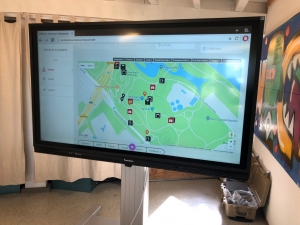
COP in use during Rhein-in-Flammen 2018
Common Operational Picture (COP): The COP is the main interface for providing human professional operators knowledge on the event in order to take informed decisions on environment and crowd control. The COP can combine crowd monitoring with sound monitoring to give event managers a complete overview of the situation. It can be connected to any number of large-screen displays in the control room. Working as a webserver solution, it can be combined with most existing types of control room monitoring infrastructure.
Decision Support System (DSS): Provides recommendations and proposes actions for the human operator based on camera and Sound Level Meters’ data as well as from input from other IoT devices such as wristbands. The DSS can solve problems and make interactive decisions by analysing massive streams of data in real-time. The DSS supports security use cases such as to crowd incidents, sound management (sound limits, sound contribution, annoyance level), missing persons and locating security personnel. The DSS can also handle sound management, such as sound limits compliance and sound contribution analysis.
Two-way communication between staff: The staff wearable wristbands contains a UWB radio that provides a reliable communication channel relatively insensitive to interference compared to narrow- or broadband alternatives. A MONICA protocol supports bi-directional communication with other staff wearables.
Alerts: The MONICA Crowd Management and Communication solution simplifies coordination between staff members and the control room for faster reaction to remedy any situation in the field. High-risk queues or other crowd incidents detected by the MONICA Crow and Capacity Monitoring are reported via the COP and the DSS to control room personnel. The staff can then direct on-site personnel to proper intervention and send selected information from the COP to support the interventions. Further, on-site staff can via the two-way communication network acknowledge the commands and send reports back to the control room on the situation as it unfolds.
Staff communication: As an extension to the COP, the MONICA Crowd Management and Communication solution facilitates real-time visual, audio and written communication between staff onsite and the control centre. Devices applied cover smart glasses, IoT staff wristbands and staff tracker. On-site personnel can report the incident to the control centre by sending live video stream and images, staff wristbands and
Staff wristbands: Staff wristbands makes it possible to locate and communicate to staff members in real time If there is an incident, the staff can press a button on the wristband to ask for assistance and thereby automatically call upon the nearest available colleague. A LCD screen, 3 buttons, vibrator and buzzer can be programmed for input and output. The UWB radio infrastructure captures the position of the wristbands using triangulation techniques and it is possible to view all staff locations on a map layer on the COP.
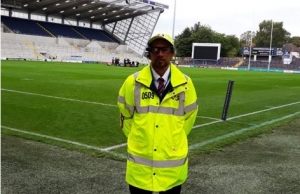
Work colleagues, fans and even the professional rugby players who Preston Binns was detailed to protect responded positively to the idea of the smart glasses. In total, three stewards and five fire fighters tried and assessed the glasses.
Smart glasses: On-site safety and security stewards can use smart glasses to report incidents to the control centre. They can send live video stream and images to support the team in evaluating the situation and whether additional security personnel should be despatched to the scene. GPS coordinates are automatically captured by the smart glasses to show the exact position of the reporting steward on the COP
Live Positioning Information System: Resilient GPS staff trackers using LoRa communication networks make it possible to locate and track staff members in real time in large areas for a better coordination of interventions. The positions can be shown on the COP as a digital map overlay.
The MONICA Crowd Management and Communication solution provides the event organisers with a reliable overview platform and a tailored communication system that supports efficient and timely management of incidents during large events. Control room overview combined with efficient staff communication is a crucial factor in handling critical incidents.
Safety and security responsible teams can benefit from improved support in detecting potential critical incidents, as well as in handling and reporting such incidents.
From the control room, security staff can inform on-site personnel of an emerging situation and coordinate the response. Being able to share information with team members, will improve the assessment of a situation and therefore improve the efficacy and speed of the intervention required at the site. Such timely support can help security personnel prevent a situation from escalating.
- The benefits for event organisers are: being able to support on-site safety and security personnel to detect, report and handle incidents in a timely manner. By combining different applications and devices to collect and transmit relevant data to the COP, the DSS can help to detect potentially dangerous situations. The control room can use the COP to locate on-site personnel and be better able to coordinate a response team to handle incidents.
- The benefits for on-site safety and security personnel are: improved support from the control room as their location is constantly known and they can send images, live video and audio to get support from team members in assessing the situation. Should an incident occur, other team members can arrive in a timely fashion to support the handling of the incident and potentially preventing it from escalating.
Ultimately, the safety and security of event visitors and staff is improved.
Technologies
The MONICA Crowd Management and Communication solution is based on a user interaction platform, the MONICA COP (Common Operational Picture), which visualises situational data captured by MONICA IoT sensors. The COP is enhanced with the MONICA DSS (Decision Support System) for automatic assessment of potential critical situations and is connected to various MONICA feed-back solutions for two-way communication with field staff such as stewards, police, security staff, emergency responders, etc.
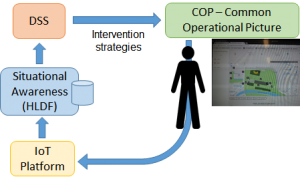
COP Principle of operation
The MONICA Crowd and Capacity Monitoring solution provides data from cameras with different analytics algorithms, and from crowd wristbands, staff wristbands, smart glasses, and GPS staff trackers to support the communication between staff members and teams. Also sound and noise management can be performed (even simultaneously with the crowd management) using the COP with data from the MONICA Sound Level Monitoring solution and the MONICA Adaptive Sound Field Control solution.
For developers:
💻 Common Operational Picture
🔐 Security, Privacy and Trust
The entire solution is embedded in a MONICA Cloud structure as described in the MONICA Platform Architecture and Components. The cloud solution is based on standard cloud server infrastructure such as the Atos Managed Public Cloud.
The MONICA Crowd Management and Control solution consist of the following components:
MONICA Common Operational Picture (COP): The MONICA Common Operational Picture (COP) control room solution aggregates all the information from the area under surveillance and displays it in real-time and incorporates the interactive Decision Support solution for the control room staff. It includes live heatmaps of crowd density and capacity, sound and noise.
Heatmap of crowd density in real-time during Woodstower festival in Lyon, 2019
It also shows the position of varies types of staff on the ground and existence of detected objects or incidents.
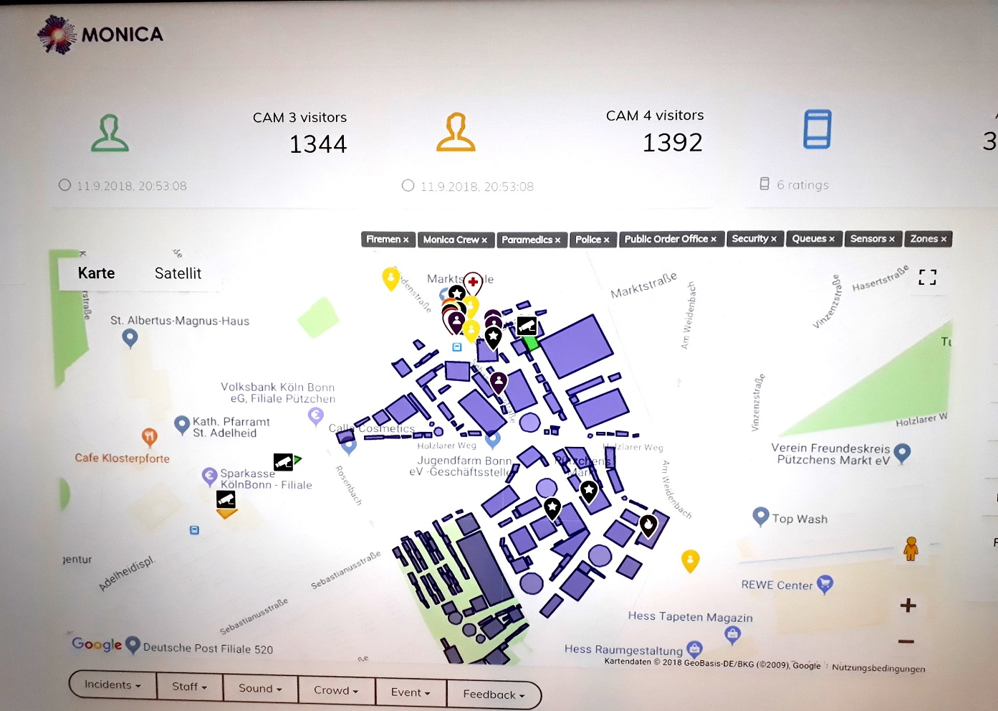
The COP displaying crowd data and visitors counts from Pützchens Markt event 2019 in Bonn
The COP consists of a database representing the current status at the event and a user interface. The data in the COP Data Base is exposed to other MONICA components through a service layer with an API. The DSS can be integrated into the COP and used to issue alerts related to e.g. crowd capacity levels, crowd movements and sound levels based on data collected and processed from deployed MONICA devices, e.g. CCTV cameras and crowd wristbands. The processed data will be visualised as e.g. heat maps superimposed on the map of the event site.
The COP enables the control room staff to make decisions on emerging issues and take preventative or responsive action based on accurate, real-time information. The COP also communicates these decisions to advanced wearable devices that allow security and first responder personnel in the field to be notified, in real-time, of incidents such as fights or high-risk queues.
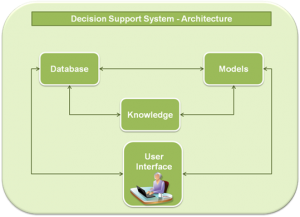
Decision Support System concept
MONICA Decision Support System (DSS): The DSS component offers recommendations and proposes actions for the human operator based on data from CCTV cameras, Sound Level Meters, wristbands as well as input from other IoT devices. It is based on a decision tree that combines fuzzy rules and expert knowledge.
The DSS is customized to the needs of end users; it parses information directly from the database, depending on user needs and the type of decision that must be made.
The core of the Decision Support System is rule-based and consists mainly of actions, conditions and rules, the final result of which is affected by the credibility factor. Each of them forms a separate class:
Actions: The “Actions” class, returns the description of each action and its degree of fulfilment.
Conditions: The “Conditions” class receives the condition parameters as an input, calculates the membership function and then returns a fulfilment pair that includes the fulfilment degree and the description of a condition.
Rules: The “Rule” class first calculates the mean of all preconditions. Then, the precondition’s mean is multiplied with that rule’s credibility factor in order to determine the rule’s degree of fulfilment. Information of all actions, conditions and rules is contained in the input JSON file and is parsed during the setup phase of the application.
Security, Privacy and Trust Framework: The aim of cyber security, privacy and trust framework is to address the privacy and security of technical issues within the MONICA IoT infrastructure, which is expected to share critical information with components involved in the pilot sites.
Staff wristbands edge layer: Staff wristbands are used for two-way communication between control room and the stewards in the field. The wristbands use Ultra-Wideband (UWB) two-way communication and incorporate a LED screen for use interaction. UWB-based geometrical localization is used for positioning. The infrastructure is comprised of anchors, tags, a network router, a network switch and a server running the location engine and configuration software.
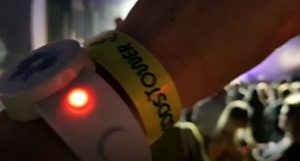
Crowd wristband, Woodstower 2019
Crowd wristbands edge layer: The low-cost crowd wristbands are equipped with LEDs and a user interaction button that can be used to collect user input from the visitors (“Likes”, voting, etc). Crowd density can be accomplished by having visitors wearing crowd wristbands which provides anonymous localisation of visitors in the event area. The crowd wristbands were used during the Nuits Soneres concerts 2018 in Lyon. LED were used to create synchronised lightshows with the concert goers.
Smart glasses edge layer: The MONICA Crowd Management and Communication solution uses the Optinvent ORA-2 smart glasses which have a built-in camera and communication means to send images and live video feeds to the control room, to receive texts and alerts and to send acknowledgements. The smart glasses are operated by either a handheld joystick or using a touch pad on the side of the glasses. The smart glasses have transparent display and is a fully standalone Android device that can run any other Android application.
The COP displaying GPS staff tracking positions (signal strength) during Pützchens Markt event 2019
Live Positioning Information System (LiPS): GPS LoRa staff trackers allow the control room to track the location of staff for a better coordination of team response actions to incidents on-site. The tracker updates the location every 5 seconds allowing the control to view the staff’s positions on a map on the COP in real time. An Open Source program that displays GPS positions with coordinates from MQTT messages on a map is available at GitHub here: https://github.com/MONICA-Project/lora-map.
The MONICA Crowd Management and Communication solution uses a broad range of communication network infrastructures and protocols, each suited to a specific part of the internal and external communication infrastructure. Communication protocols have in many cases been enhanced with additional plugins developed by MONICA partners.
WAN communication: MONICA relies on standardised communication networks such as wide-area 3G/4G/5G telecommunication infrastructure, The MONICA COP requires a fast cloud Internet connection for minimum latency. Some devices, such as the SLM, may use 3G/4G network communication. GPS trackers uses LoRa communication infrastructures.
Wireless LAN communication: A stable WiFi network is required to avoid data loss and a high bandwidth for advanced functionalities requiring audio recording such as source contribution identification. The Sandrato wristbands uses UWB (Ultra Wide Band) communication whereas the Sandrato crowd wristbands use 868Mhz networks and proprietary communication protocols.
Wired LAN communication: CCTV cameras uses Ethernet with PoE (Power over Ethernet) LAN networks.
The security and privacy features are ensured by the MONICA Cyber Security, Privacy and Trust Framework.
The MONICA Crowd Management and Communication solution is a complex solution that relies on both external components and technologies as well as components, enablers and tools from the MONICA project partners. Please contact the responsible partner listed below for more information.
The entire solution is embedded in a MONICA Private Cloud structure as described in the MONICA Platform Architecture and Components.
MONICA Private cloud services
The MONICA architecture comprises the following subsystems, also called layers, as described in the MONICA Platform Architecture and Components.
- The IoT Layer is composed of three subcomponents: a) The Adaptation Layer providing technology independent management of physical resources and uniform mapping of data into standard representations, b) the Middleware offering storage and directory services for resources registered in the IoT platform; and c) the External IoT Platform Connectors, handling the communication with external IoT platforms and the integration of data coming from outside e.g. through the OneM2M Network Service Capabilities Layer (NSCL);
- The Services Layer, where the intelligence of the platform is implemented and specific processing modules are integrated to provide technical solutions compliant with the application requirements;
- The MONICA APIs Layer, which provides service access points for MONICA application developers and external application developers that want to access MONICA functionalities and information streaming from the platform;
- The Cyber Security and Privacy Framework, enabling trust-based communication, policy management and technical support across all levels of the platform. More specifically, this framework ensures secure data flows and storage, protected information exchange and trusted federation mechanism to facilitate private information sharing;
- The Deployment and Monitoring Tools. These tools belong to a transversal framework able to simplify the platform deployment (g. modules belonging to the Device and Network layers) and used for checking the operational status of the devices, networks and overall system.
MONICA Private cloud integration
In the MONICA IoT Platform, Data Sources API functions as interface layer between the MONICA IoT Platform and the MONICA Cloud services as described in the MONICA Platform Architecture and Components. The following layers are described in the MONICA Crowd and Capacity Monitoring solutions:
- The Device Layer includes all IoT wearables
- The Network Layer allows effective communication between IoT devices and the IoT Platform
- The Edge Layer includes a set of modules for real-time data processing
The MONICA Platform Architecture and Components provides further details about the behaviour of each system’s component and related subcomponents, including architectural elements that deliver the system’s functionality.
External technologies required
The cloud solution is based on standard cloud server infrastructure such as the Atos Managed Public Cloud.
Internal MONICA enablers and tools required
- MONICA Common Operational Picture (COP)
- MONICA Decision Support System (DSS)
- MONICA Cyber Security Privacy and Trust Framework
- MONICA Private cloud services
Scalability
The following scalability issues should be considered:
Scalability of the MONICA COP: The MONICA COP requires a fast internet connection for minimum latency. The Smart Glasses Monicora app is different from apps on mobile phones, since it executes on an extremely small processor embedded in the glasses. Although the app can be customised, it is limited in terms of features that can be implemented. Hence, it requires a more powerful platform such as the COP to provide advanced features. One COP is able to control several Smart Glasses at the same time
Scalability of the high-level network infrastructure: The theoretical assumption is that the High-Level Network Infrastructure scales up to a thousand nodes or more for large-scale IoT deployment. However, for MONICA deployment, the network might scale to just hundreds of nodes in a single network for large-scale deployment linked together via an 802.11 backbone due to data rate and duty cycle requirements of a typical application. To achieve better scalability, the coverage area of the access points within the MONICA pilot is the key parameter. Table 9 shows the relationship between coverage range and link capacity for both IEEE 802.11a/b.
Scalability of the cloud infrastructure: To Scale Vertically (or Scale-Up): this type of scalability can work with any application to a limited degree. To scale vertically means to add resources to a single node in a system, typically involving the addition of processors or memory to a single computer. Such vertical scaling of existing systems also enables them to use virtualization technology more effectively, as it provides more resources for the hosted set of operating system and application modules to share. An example of taking advantage of such shared resources is by increasing the number of Apache daemon processes running. To Scale Horizontally (or Scale-out): scaling a system by adding hardware resources horizontally and then dividing the load between them. Horizontal scaling is similar to elasticity; it allows the reallocation of resources between applications by provisioning, or by claiming back virtual machines. Horizontal scaling uses the infrastructure elasticity, but the application needs to be able to scale by adding more nodes and by distributing the load. To scale horizontally means to add more nodes to a system, such as adding a new computer to a distributed software application. An example might be scaling out from one web-server system to a system with three web-servers.
Associated MONICA solutions
- The MONICA Crowd Management and Communication solution: is closely related to and have been demonstrated together with the MONICA Crowd and Capacity Monitoring solution for a complete IoT enabled, closed-loop security solution. But despite this, the two solutions may be used independently.
- The MONICA Crowd Management and Communication solution have also been demonstrated with the MONICA Sound Level Monitoring solution for providing heat maps of sound levels during concerts. It is also closely associated with the MONICA Adaptive Sound Field Control solution providing environmental and sound monitoring data.
Implementation
The MONICA Crowd Management and Communication can be implemented as a customer specific solution independent of other MONICA solutions.
Preparation
The following information should be investigated and prepared before implementation is commenced:
Control room: The availability of the following assets should be investigated and planned before implementation is commenced: Availability of network/power, availability of high-speed internet connection, general control room facilities such as tables and chairs, display screens.
Event location: A map of the venue should be provided in order to plan the position and the amount of the equipment to be installed. Also, the availability of, and access to, elevated places to mount wristband anchors and LoRa antennas should be identified. Finally, the availability of power and internet access should be investigated for each equipment and mapped.
Wristband infrastructure: The staff wristbands operate at a high frequency so buildings/walls/trees can negatively influence this. Generally, the venue should be a large indoor or outdoor open space with low complexity: an indoor venue with many rooms or an outdoor space inside a city centre are not feasible. Ten anchors can cover app. 2.500m2. At least one Ethernet connection is required for the master anchor.
Deployment
Wristband infrastructure: It is strongly advisable that DEXEL (or another partner that has been properly trained) is hired to supervise the installation. The COP should be set up in a control room where qualified control room operators can monitor the incoming data.
Operation
The supplier of the MONICA Crowd Management and Communication should be at hand during the event to support the event organiser. The support can be delivered remotely.
The DEXEL (or another partner that has been properly trained) should be hired to supervise operation of the wristband infrastructure.
Reproducibility means that a MONICA solution (including data sets, software code, etc) can be made available to others for reproducing the same results.
Part of the Crowd Management and Communication Solution can be demonstrated and reproduced thanks to the Staff Management Toolbox. Anyone with the docker supported computer can run the demonstration following the instruction specified in the toolbox tutorial.
The toolbox instantiates different components of the MONICA toolchain as docker containers, namely SCRAL, OGC Sensorthings storage and Common Operational Picture. The entire setup can be verified with the help of a docker container called gpsfaker. Once the data is populated, different components can be validated with the help of corresponding endpoints as mentioned in the README file of the toolbox.
Additional resources:
The MONICA Staff Management Toolbox:
Technical regulations
Interoperability in MONICA is achieved also thanks to the adoption of several open standards. The standards adopted by the MONICA platform are the following.
Device/NWK Layer
- Bluetooth BLE / DASH7 / Wi-Fi – IEEE 802.11
- UWB – ETSI EN 302 065-2 V 2.1.1 – EU Commission Implementing Decision 2014/702/EU, and IEEE 802.15.4a
- ETSI EN 302 065-2 V2.1.1 for UWB staff wristbands
- ETSI EN 300 220-2 V3.1.1 crowd wristbands
- IETF (Internet Engineering Task Force) 6LoWPAN (an acronym of IPv6 over Low -Power Wireless Personal Area Networks). / IETF ROLL (Routing Over Low power and Lossy networks) / IETF CoAP (The Constrained Application Protocol)
- OASIS (The Organization for the Advancement of Structured Information Standards) MQTT (Message Queuing Telemetry Transport) Protocol
- Ontology
- ETSI SAREF (Smart Applications REFerence ontology).
https://saref.etsi.org/saref/latest/saref.html - Security
- IETF Oauth 2.0 (Open-standard authorization internet protocol) / OASIS XACML (eXtensible Access Control Markup Language), an architecture, and a processing model describing how to evaluate access requests according to the rules defined in policies.
IoT Platforms
- oneM2M Network Service Capability Layer / GW
Data format / API
- OGC (Open Geospatial Consortium) SensorThings API (The OGC SensorThings API provides an open, geospatial-enabled and unified way to interconnect Internet of Things (IoT) devices, data, and applications)
Architecture Design and Documentation
- ISO/IEC/IEEE 42010:2011 (ISO/IEC/IEEE 42010:2011, a standard addressing the creation, analysis and sustainment of architectures of systems, through the use of architecture descriptions.
- AIOTI HLA (Alliance for Internet of Things Innovation)
https://aioti.eu/wp-content/uploads/2017/06/AIOTI-HLA-R3-June-2017.pdf - The staff wristbands should be compliant with ETSI EN 302 065-2 V 2.1.1
https://www.etsi.org/standards-search#page=1&search=EN300%20392&title=1&etsiNumber=1&content=1&version=0&onApproval=1&published=1&historical=1&startDate=1988-01-15&endDate=2016-10-10&harmonized=0&keyword=&TB=&stdType=&frequency=&mandate=&collection=&sort=1 - The staff wristbands should be compliant with EU Commission provisions 2014/702/EU
https://eur-lex.europa.eu/legal-content/EN/TXT/?uri=CELEX%3A32014D0702 - The crowd wristbands should be built to comply with ETSI EN 300 220-2 V 3.1.1
https://www.etsi.org/standards-search#page=1&search=EN300%20392&title=1&etsiNumber=1&content=1&version=0&onApproval=1&published=1&historical=1&startDate=1988-01-15&endDate=2016-10-10&harmonized=0&keyword=&TB=&stdType=&frequency=&mandate=&collection=&sort=1 - The UWB communication should be compliant with the IEEE802.15.4-2011 standard.
- The hardware must comply with the Waste Electrical and Electronic Equipment Directive (WEEE 2012/19/EU).
- The CCTV cameras and other hardware sensors are an electronic equipment and the supplier and the organiser must agree on the proper take-back procedure for the used hardware.
- The hardware must comply with the Restriction of Hazardous Substances in Electrical and Electronic Equipment Directive (RoHS 2011/65/EU).
- The hardware must be marked with the WEEE mark.
The IoT elements of the MONICA Crowd Management and Communication solutions making use of radio frequency spectrum must adhere to the various European regulatory provisions as laid forth by CEPT/ECC in conjunction with some relevant EU Decisions. For further information see D12.5 Report on Standards, Regulations, and Policies for IoT Platforms.
Other local/national regulations
With regard to the collection and processing of personal data, the GDPR allows Member States to enact national provisions on certain issues as stipulated by the National Data Protection Authority. For example, Member States will have discretion to enact national provisions imposing further requirements regarding the appointment of Data Protection Officers.
When MONICA solutions are used to collect and/or process personal data, the following general topics need to be considered to be GDPR compliant:
- Processing data based on consent must be unambiguous and involve a clear affirmative action (an opt in)
- Internal procedures must be developed to protect personal data
- Internal procedures to protect the rights of data subjects must be implemented
- Informed consent procedures and forms must be designed and collected
- The event organiser is identified as the “Data Controller”
- The MONICA provider is identified as a “Data processor”
- A Data Processor Agreement must be drafted and signed by these two parties
- Data Processor Agreements with third parties must be in place if relevant
- A Data Protection Officer can be designated by the Data Controller
- A Data Management Plan is required which established the intended processing of personal data and the purpose of such processing
- A Data Protection Impact Assessment must be carried out based on the Data Management Plan and special areas of vulnerabilities towards protection of personal data must be identified and resolved.
Ethics
The following specific ethical considerations shall be made:
- The COP should be placed in a secure room with controlled access to prevent any form of misuse of the displayed data (location of staff, pictures, videos etc.).
- If informed consent from staff (see below) needs to be collected, this should be done voluntarily and in due time prior to the deployment of the solution to allow staff sufficient time to make an informed decision.
- If the COP is used to display the location of security personnel, the involved personnel need to be informed and have provided explicit consent on an informed consent form.
- If staff wearables are used, staff need to be given detailed information of the purpose and use of the wearable and sign an informed consent form.
- If smart glasses are used, data files stored internally in the smart glasses must be deleted at the time they are no longer needed, e.g. when the event is finished. Internal procedures stating who is responsible for doing so and how the action needs to be documented should be place.
- If smart glasses are used, ways of alerting those who may be recorded should be considered. For example, a clearly visible badge could be worn.
- If the LoRa staff tracker is used, it is necessary to download an app on a mobile device (e.g. phone). Staff members cannot be expected to use their personal mobile phones for this purpose and should therefore be supplied with a suitable mobile device for this purpose.
- The solution may raise concerns about increased surveillance practices and how these affect citizens’ rights to privacy. Event organisers should define the legitimate reasons for implementing the solution. It may be useful to carry out a Legitimate Interests Assessment (LIA).
Lesson Learned has been collected throughout the deployment and demonstration phases of the MONICA project and the relevant Lesson Learned are provided here for reference. Please check with the responsible partner for the newest updates.
The following main Lesson Learned from the MONICA demonstrations and reference deployments are:
- Smart glasses may interfere with the uniforms, e.g. hats or caps, of the on-site security staff. The glasses should therefore be tested by staff in full uniform before deployment.
- LoRaWAN based trackers are a suitable alternative to overcome problems and limitations (or non-existence) of WiFi or cellular networks in low data rate scenarios.
- LoRaWAN based trackers are primarily suitable for outdoor events.
- As the RIOT-OS based GPS trackers utilize the LoRaWAN infrastructure of TheThingsNetwork it is vital to have at least one LoRaWAN gateway within range of the event site (venue).
- The use of iPhone to create ‘hot spots’ is an effective back up for areas where Wi-Fi is poor/ unavailable.
- Hardware should be installed 2-4 days prior to the event and tests should be carried out.
- During notifications of national spectrum regulatory authorities in a Member State with regard to a planned demonstration/test of new and novel (not yet CE-marked) radio devices, it has proved useful to reference Art 9(2) of the 2014/53/EU (RED), where a MONICA supported event area is compared to a tech-exhibition or trade fair. It should be observed, that the event area must be gated, to prevent non-compliant equipment incidentally to pass through any exit gate, with the risk of causing harmful interference to other wireless services. Observe also, that Art 9(2) of said directive instructs, that non-compliant devices shall be duly marked as “demonstration/not for sale”
Replication
Business Models
The Business Model Canvas is used to give a high-level overview of the contents in the value configuration and in the customer group side related to a specific value proposition. This tool is used to map out all details of the MONICA business models based on the value proposition, target groups, the partner constellations, and revenue models outlined below.
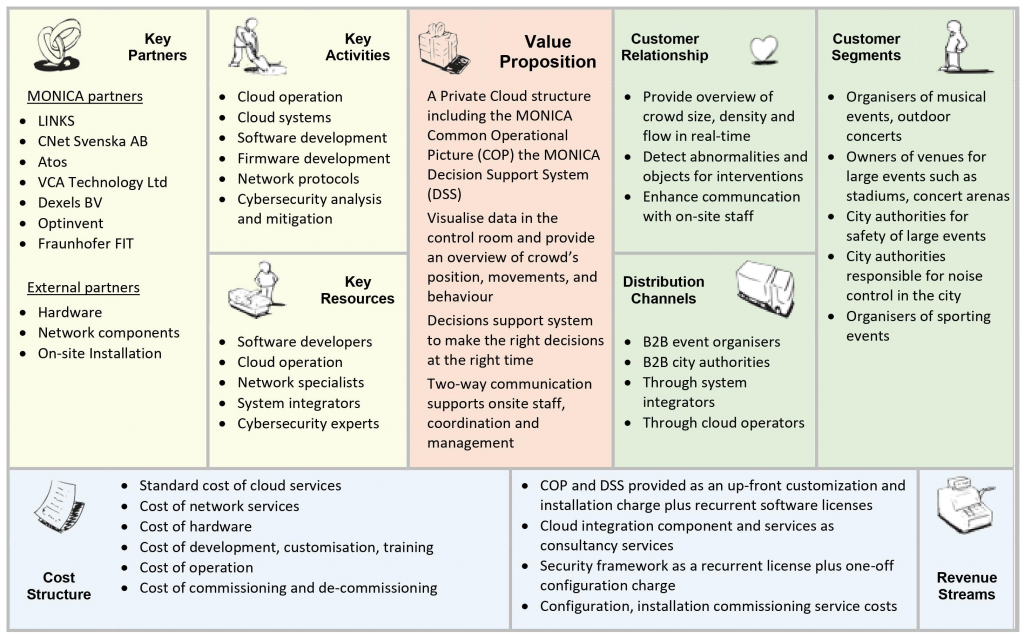
Business Model Canvas for the MONICA Crowd Management and Communication solution © In-JeT ApS
Revenue models
The choice of business model and pricing schemes is entirely up to the partner that have commercialised the solutions. Hence, the following information is solely provided as a guide to the expected business conditions that the solutions might be provided at. Please contact the responsible partner for further, up-to-date details.
| Components | Type | Anticipated revenue model |
|---|---|---|
| Common Operational Picture (COP) | Software, cloud solution | The COP software can be provided as an up-front design, development and installation charge combined with recurrent software licenses. The cloud hosting is provided at standard cloud solution costs. |
| Decision Support System (DSS) | Software | The DSS software can be provided as an up-front design, development and installation charge combined with recurrent software licenses. |
| Security privacy and trust framework | Software, cloud solution | The Security privacy and trust framework will be sold as a recurrent software license plus one-off configuration charges. The cloud hosting is provided at standard cloud solution costs. |
| Staff wristband edge layer | Hardware, firmware, software | The wristband components are offered at a commercial one-off cost per wristband. The firmware is included in the cost. The infrastructure is either provided as one-off costs or is offered as a complete rental including design, installation and operation during the event. The software for MONICA COP integration is offered at a one-off license per installation. |
| Smart glasses edge layer | Hardware, firmware, software | The smart glasses components are offered at a commercial one-off cost per glass. The firmware is included in the cost. The software for MONICA COP integration is offered at a one-off license per installation |
| Staff real-time positioning edge layer | Hardware, firmware, software | The positioning devices and LoRa interfaces are offered at a commercial one-off cost per user. The firmware is included in the cost. The use of LoRa is offered by the network provider. The software for MONICA COP integration is offered at a one-off license per installation. |
Reference deployments in MONICA
During the project period 2017 – 2020, the MONICA Crowd Management and Communication solutions in various forms were deployed and tested in real-life situations during planned pilot events. Validated results from these reference implementations can be found in D9.2 Final Assessment and Validation Report of the MONICA IoT Platform. Follow the links below to read articles about the demonstrations.
| MONICA demonstration events | |
|---|---|
Ville de Lyon
|
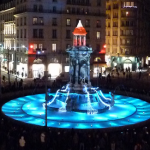 Fête des Lumières 2018 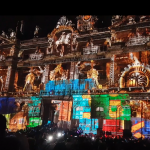 Fête des Lumières 2019 |
Città di Torino
|
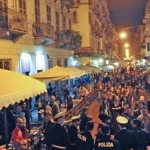 San Salvario  Kappa FuturFestival 18  Kappa FuturFestival 19 |
Stadt Bonn
|
 Pützschens Markt 18  Puetzchens Markt 19  Rhein-in-Flammen 19 |
Tivoli, Copenhagen
|
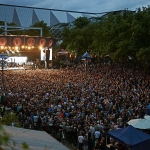 Tivoli Fredagsrock |
Stadt Hamburg
|
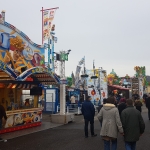 SpringDOM 2019 |
Leeds Cricket & Rugby
|
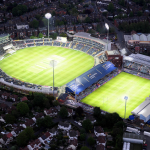 Headingly Stadium 18 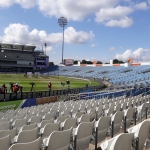 Leeds Cricket 18 |
For more information, please see the contact list below
Replicators
During the project, the MONICA Sound Level Monitoring solution was deployed and tested in real-life situations in events outside the planned MONICA demonstrations. These events were suggested by external partners due to their interest in the MONICA solutions. Please contact the organisers for further information.
| MONICA Replication events | |
|---|---|
| Lyon |
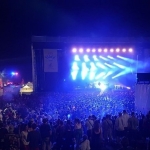 Woodstower 2019 |
The following partners are responsible for various components of the MONICA IoT SLM solution:
| Solution | Responsible | Acronym | Details |
|---|---|---|---|
| MONICA Private cloud services | Atos | ATOS | ATOS can provide the cloud infrastructure and the system integration
. |
| MONICA Common Operational Picture (COP) | CNet Svenska AB | CNET | CNET can provide the software for the COP |
| MONICA Decision Support System (DSS) | CERTH Information Technologies Institute | CERTH | CERTH can provide the software for the DSS |
| MONICA Security privacy and trust framework | Atos | ATOS | ATOS can provide the cyber security privacy and trust framework |
| MONICA IoT and edge layers | Links | LINKS | LINKS can provide the MONICA IoT integration components |
| Staff and crowd wristbands interfaces for COP | Dexels/Sendrato | DEXELS | Sendrato can provide the hardware wristbands. Dexels can provide the firmware and the communication infrastructure |
| Smart glasses interfaces for COP | Optinvent S.A. | OPTIN | OPTIN can provide the hardware and the firmware for the wristbands |
| Staff real-time positioning interfaces for COP | Fraunhofer FIT | FIT | FIT can provide the GPS location devices with LoRa communication interfaces |
